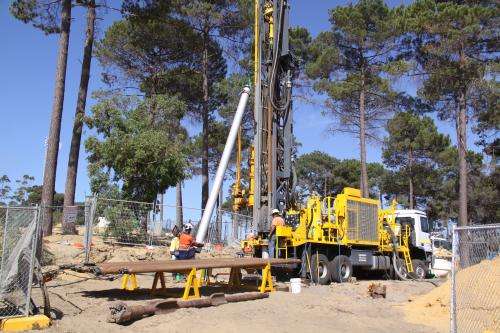Cooling solution for supercomputer heralds new age in renewable energy

The development of a renewable system for cooling Australia's largest supercomputer is a step closer, following the start of an innovative geothermal energy project in Perth.
In what will be an Australian first, the CSIRO Geothermal Project will deliver a novel solution for cooling the Pawsey Centre supercomputer, an A$80 million facility currently under construction in Kensington, south Perth.
"The system is known as groundwater cooling, and works by pumping cool water from a depth of around 100 metres through an above-ground heat exchanger to cool the supercomputer, then reinjecting the water underground again," said CSIRO's project director, Steve Harvey.
"Although the water returned to the aquifer is a few degrees warmer than the surrounds, the groundwater cooling system is engineered to prevent negative impacts to the surrounding environment."
With zero net use of groundwater, the system is also environmentally friendly. CSIRO estimates that using groundwater cooling to cool the Pawsey Centre supercomputer will save approximately 38.5 million litres of water every year, in comparison to using conventional cooling towers. That's enough to fill more than 15 Olympic-sized swimming pools. If deployed more widely, the technology also has the potential to replace cooling towers in buildings all over Perth.
Drilling work to implement the groundwater cooling system has recently got underway at the Australian Resources Research Centre (ARRC) in Kensington's Technology Park - the same site that houses the Pawsey Centre supercomputer. The challenge of cooling the new petascale computing system - which will provide expertise to support the world's largest-ever radio telescope (the Square Kilometre Array) and other high-end science - was one of the driving forces behind the CSIRO Geothermal Project.
"Computers generate lots of heat, as anyone who has sat with a laptop on their knees will know," said Steve Harvey.
"Supercomputers, as you can imagine, use large amounts of electrical power, almost all of which is turned into heat and requires cooling. Recent global changes in the cooling requirements for supercomputers, however, means that we can now use water of an ambient temperature, as opposed to chilled water. That's where groundwater cooling comes in."
As well as using a shallow geothermal solution to cool the supercomputer, the CSIRO Geothermal Project will also investigate a potentially deeper geothermal energy resource located beneath the ARRC site by constructing a 3km deep exploration well later this year.
Provided by CSIRO



















